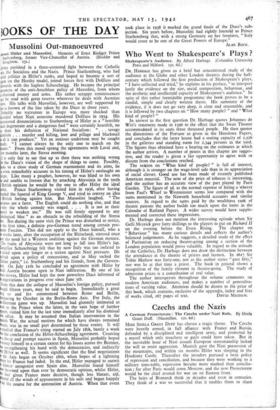Who Went to Shakespeare's Plays ?
DR HARBAGE has given us a brief but concentrated study of the audience at the Globe and other London theatres during the half-
century which followed the first production of Shakespeare's plays.
" I have collected and tried," he explains in his preface, " to interpret justly the evidence on the size, social composition, behaviour, and the aesthetic and intelleculal capacity of Shakespeare's audience." In spite of this rather formidable programme the book proves to be a candid, simple and clearly written thesis. His summary of the evidence, if it does not go very deep, is clear and reasonable, and it is followed by two chapters on " How many people? " and " What kind of people? "
In answer to the first question Dr. Harbage quotes Johannes de Witt's statement made in 1596 to the effect that the Swan Theatre accommodated in its seats three thousand people. He then quotes the dimensions of the Fortune as given in the Henslowe Papers, and concludes that the latter house had a seating capacity of 1,526 in the galleries and standing room for 2,344 persons in the yard. The figures thus obtained have a bearing on the estimates at which the author arrives. A number of points in this chapter are sugges- tive, and the reader is given a fair opportunity to agree with or dissent from the conclusions reached.
The section on " What kind of people? " is full of interest, although it is stronger on the wage-level side than in its appreciation of social classes. Good use has been made of recently published American material. The note of the price of tobacco is interesting, and the author has an accurate view of the part played by Paris Garden. The figure of 3d. as the normal expense of hiring a wherry from Paul's Wharf to Westminster seems low compared with the sums mentioned in the Naworth household accounts and similar sources. In regard to the sums paid by the wealthiest rank of theatre patrons the author builds too much upon the items in the Calendar of Rutland Papers. A wider survey would have supple- mented and corrected these impressions.
Dr. Harbage does not mention the interesting episode when Sir Gelli Meyrick gave forty shillings to the players to put on Richard II on the evening before the Essex Rising. The chapter on " Behaviour " has many curious details and reflects the author's balanced judgements. As he suggests, a detailed study of the effect of Puritanism on reducing theatre-going among a section of the London population would prove valuable. In regard to the attitude of the Catholics, Dr. Harbage does not draw the distinction between the attendance at the theatre of priests and laymen. In 1617 Sir Tobie Mathew was forty-one, not as the author states " past fifty," nor was he at that time a priest. The book in general shows a recognition of the family element in theatre-going. The study of admission prices is a contribution of real value.
The author intersperses throughout the volume comments on modern American audiences, and makes a number of generalisa- tions of varying value. Attention should be drawn to the price of this book, which contains, exclusive of the appendix, index and lists of works cited, 167 pages of text. DAVID MATHEW.


























 Previous page
Previous page